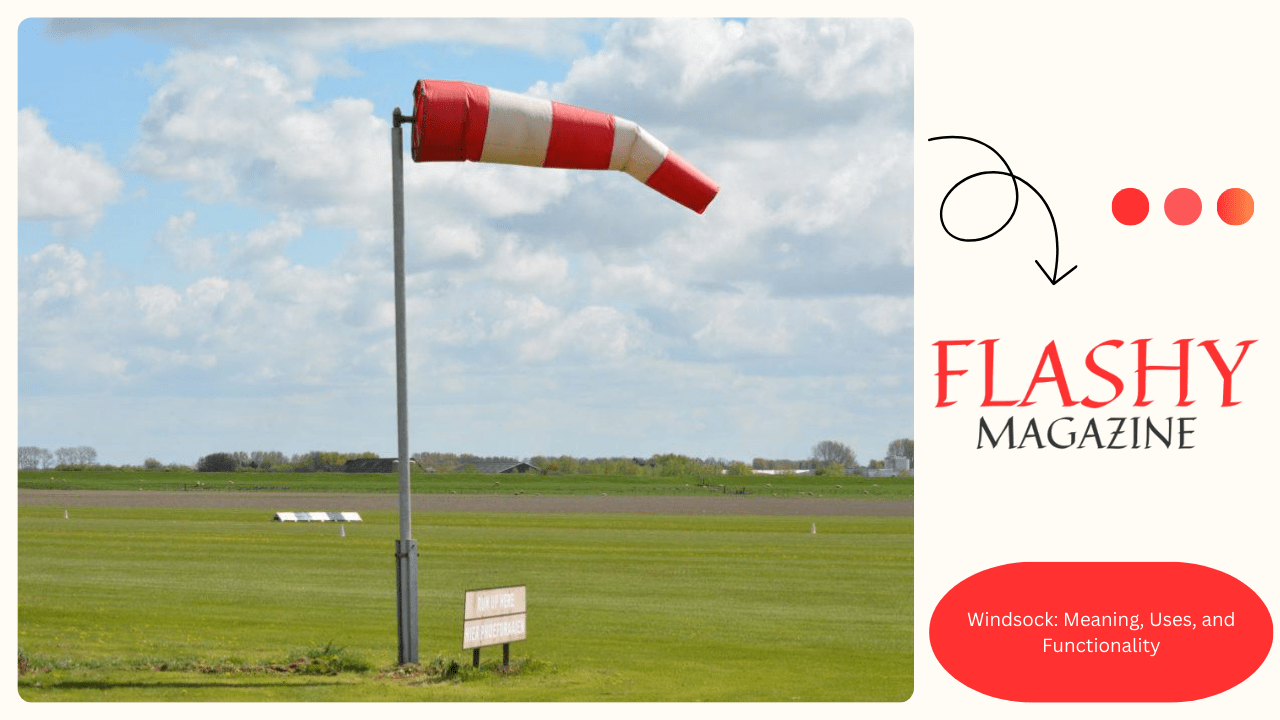Windsock are a common sight at airfields, airfields, roadways and artificial installations and give a simple but vital function in measuring wind direction and speed. Windsock, frequently made of featherlight fabric and attached to poles, visually indicate real- time wind characteristics to help aviators, motorists and workers make safe and informed opinions. Although their function may feel introductory, Windsock are pivotal in a variety of fields, from aeronautics to environmental monitoring.
Preface to Windsock
A wind sleeve is a simple but essential tool for observing wind patterns. Used in a number of diligence, from aeronautics to transportation and environmental monitoring, wind sleeves give precious data on wind direction and speed. Their vibrant colors and prominent placement help make them visible from hence, allowing people to snappily assess wind conditions in the areas where they’re installed. Wind sleeves have a long-standing part in promoting safety and serve as a protean tool for anyone who needs to navigate the ever- changing forces of nature.
History and Origin of the Windsock
The origin of the windsock is unclear, although analogous bias were used in ancient times by societies that reckoned on wind patterns for navigation and rainfall soothsaying. Ancient Chinese and Japanese societies used tubular flags to indicate wind direction for military and conventional purposes. In the early 20th century, windsocks came standardized tools in aeronautics to guide aviators during takeoff and wharf by furnishing clear visual cues about wind geste.
How Windsock Work
The wind sleeve works by responding to wind pressure and direction. A wind sleeve is made of a cone- shaped cloth tube attached to a circle or pole and points in the contrary direction to the origin of the wind, indicating its source. The sock inflates with increased wind speed, allowing observers to visually gauge the direction and strength of the wind. The size of the lift of the wind sleeve corresponds to the wind speed; a fully vertical windsock indicates stronger winds, while a incompletely raised windsock indicates lighter gusts.
Physical Parcels of Windsocks
Windsock are generally designed with a phased conical shape that optimizes tailwind and improves visibility. They frequently feature largely visible colors similar as orange, red and white, icing they can be seen from a distance. numerous wind sleeves are equipped with rings or frames on the opening to maintain structure and help tangling.
Types of Windsock
Windsock come in several kinds, each designed to serve specific requirements in different diligence.
Aviation Windsock
These wind sleeves are most generally set up at airfields, airfields and pads. They play a vital part in aeronautics safety by furnishing aviators with real- time wind speed and direction data, which is essential for safe levees and takeoffs.
Artificial Windsock
Diligence dealing with dangerous chemicals or unpredictable substances use wind sleeves to cover wind direction and insure that smothers and feasts are directed down from workers. These windbreakers are frequently made of durable accoutrements that can repel exposure to harsh environmental conditions.
Marine Windsock
In the marine terrain, wind sleeves help hearties and boat drivers gauge wind conditions that may affect navigation and docking. Sea wind sleeves are generally leakproof and can repel exposure to swab water.
Recreational Windsock
Windsock are also used in recreational conditioning similar as paragliding, soaring and vampire flight. They give actors with an understanding of wind patterns and allow them to acclimate consequently for a safe and pleasurable experience.
Accoutrements Used in the Manufacture of Windsock
The choice of material affects the continuity, visibility and functionality of the Windsock.
Nylon
Nylon is generally used due to its featherlight and durable parcels. It resists wear and tear and gash, making it suitable for long- term out-of-door use.
Polyester
Polyester is another popular material, valued for its resistance to UV radiation and color fastness. Polyester windproof covers are ideal for places with violent sun.
Fabrics Resistant to UV Radiation
Specialized UV- resistant fabrics help help color fading, extending the life of the wind sleeve and icing it remains visible and effective over time.
Significance of Windsock in Aviation
In aeronautics, windsocks are necessary tools that give aviators with vital information.
Understanding Wind Direction and Speed
Wind direction and speed are critical in determining the safest approach for takeoff and wharf. By understanding these factors, aviators can acclimate their wharf ways and control the aircraft more effectively.
Increased Safety During Wharf and Takeoff
Visual cues allow aviators to make split-alternate opinions, especially during crosswind levees where strong crosswinds can affect flight safety. Windsleeves located near runways serve as essential pointers that can increase safety during these critical phases of flight.
Windsock in an Artificial Terrain
In an artificial terrain, wind sleeves help cover dangerous material running and insure worker safety by indicating which direction feasts or vapors may be moving.
Running of Dangerous Material
Artificial shops, refineries, and chemical installations use wind sleeves to cover tailwind. In the event of leaks or tumbles, wind jackets help in emptying labor force to areas innocent by airborne hazards.
Monitoring Ventilation and Air Quality
Wind sleeves also help measure air quality and air inflow in open surroundings and help help poisonous goods by controlling responses grounded on wind patterns.
The Part of Windsocks in Environmental Monitoring
Windsock are used in environmental monitoring stations to help cover air inflow and contaminant movement. By assaying wind patterns, environmental agencies can determine the dissipation of adulterants and assess air quality in different areas.
How to Read a Windsock
Windsock position and affectation position indicate wind direction and speed.
Interpretation of Wind Direction
The direction the Windsock points indicates the origin of the wind. For illustration, a windsock pointing north means the wind is blowing from the south.
Estimation of Wind Speed Grounded on the Position of the Windsock
Wind sleeves generally contain parts or bars, with each member representing a range of wind pets. A completely extended windsock indicates strong winds(generally around 15 knots or further), while a incompletely inflated windsock indicates weaker winds.
Installation and Conservation of Windsock
Proper installation and conservation are crucial to the functionality and life of the Windsock.
Choosing the right position
Windsock should be installed in open areas, down from obstructions that may intrude with wind inflow. They’re generally mounted on masts, raised above ground position to insure accurate measures.
Tips for Regular Conservation
Regular conservation includes checking for gashes, rasping and color fading. Replacing the wind cuff as demanded ensures accurate readings and maintains safety norms.
Differences Between Homemade and Electronic Windsock
Homemade windsocks calculate only on the force of the wind, while electronic windsocks are equipped with detectors that measure wind speed and direction. These electronic performances are used in advanced rainfall stations and some airfields to give more accurate data.
Windsock Size and Length Matter
Windsock come in a variety of sizes, with larger models furnishing better visibility from a lesser distance. Size and length affect how well a windsock indicates wind speed, as longer windsocks are better for measuring subtle changes in light wind conditions.
Windsock for Sports and Recreational Conditioning
Paragliding and Paragliding
In sports similar as soaring and paragliding, wind jackets help actors understand wind patterns, which is essential for determining safe jump or wharf points.
Sailing and Flying Harpies
Windsleeves also play a part in sailing, where understanding wind patterns is essential to navigation. Vampire suckers use windsocks to determine optimal flight conditions and acclimate their ways consequently.
Use of Windsock on Roadways and in Business
In areas prone to high winds, similar as mountain passes or open roadways, wind sleeves give precious information to motorists. They advise of strong crosswinds that could affect vehicle stability, especially for large exchanges and campers.
Windsock in Film and Photography
Windsleeves are occasionally used in film and photography to add movement and energy to shots. They serve as visual rudiments to indicate wind direction and intensity, help set the scene or enhance out-of-door shots.
Symbolism and Artistic Significance of Windsocks
In Japanese culture, for illustration, wind sleeves called koinobori represent complaint and are flown during Children’s Day fests to emblematize strength and adaptability. Windsleeves, with their association with the rudiments, are also symbolically used in art and design to represent rigidity and change.
How to Choose the Right Windsock for Your Requirements
Choosing a Windsock depends on your specific requirements. For aeronautics, a durable and largely visible model is essential. In an artificial terrain, look for windproof sleeves that repel chemicals and UV shafts. Meanwhile, recreational Windsock prioritize portability and ease of use.
Conclusion: The Enduring Significance of Windsock
Windsock may feel like simple bias, but their function is inestimable in numerous diligence. From perfecting aeronautics safety to maintaining assiduity protocols, they remain essential tools that give fast and dependable wind measures. Understanding wind sleeves and using them effectively can greatly increase safety and functional effectiveness, proving that these humble tools are as important moment as ever.
Constantly Asked Questions
- How does a Windsock show wind speed?
The Windsock inflates according to the wind speed. Completely exaggerated means strong winds, while incompletely inflated means lighter winds.
- What material is stylish for a Windsock?
Durable, UV- resistant fabrics similar as polyester or nylon are ideal for out-of-door wind socks as they repel fading and riding .
- Where should I install the Windsock?
Install it in an open, unstopped area to insure accurate wind readings. Elevation on the pole improves visibility and delicacy.
- Are Windsock used in environmental monitoring?
Yes, they help track wind patterns and contaminant dissipation and give birth data for environmental assessments.








